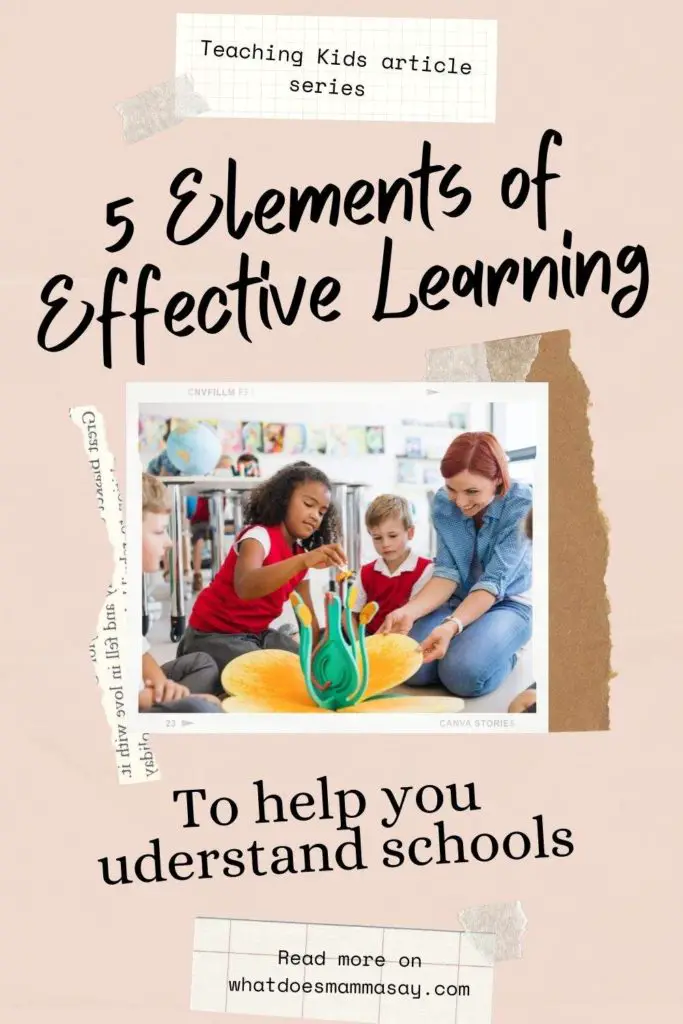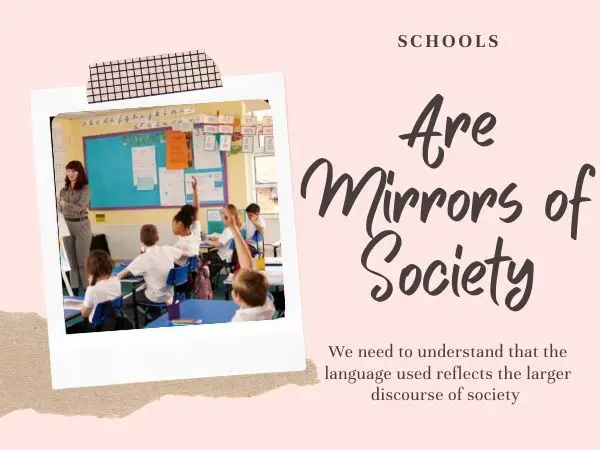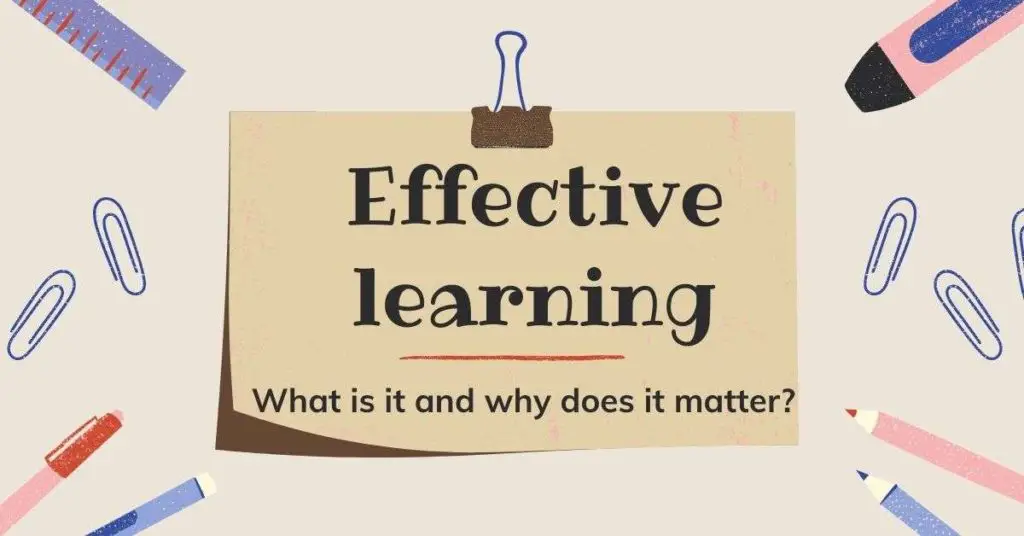Starting from the premise that ‘the most important school-related factor in student learning is teaching’1 the aim of this article is to focus on characteristics of effective learning with an emphasis on how teachers influence learning outcomes.
Across literature, it has been argued that learning professionals represent one of the main factors to influence learning2, or as researchers explain “the quality of an education system cannot exceed the quality of its teachers”3 .
However, the learning environment and all the elements that form it: curricular provision, planning, policies, as well as the larger context in which the learning environment is placed, are part of a web of relations and interdependencies that shape learning professionals, influencing their beliefs and pedagogical practices. Therefore, we will first focus on the elements that form the learning environment.
This post may contain affiliate links and I may earn a small commission when you click on the links at no additional cost to you. As an Amazon Affiliate, I earn from qualifying purchases. You can read my full disclosure here.
Characteristics of effective learning based on learning environments
Curriculum plays an important part in guiding effective learning and teaching and alongside policy and teachers’ experience, acts as an influence on pedagogical practices in the classroom4.

An effective curriculum is one that engages with the cultural resources of the community and provides a balance between skills, knowledge, concepts and attitudes5. Educational researchers further argued that a curriculum needs to be flexible enough to make space for different social and economic needs and different learners6.
Giroux and Penna (1979) argue that alongside the official curriculum, the hidden curriculum is an integral part of learning in the classroom. The hidden curriculum7 represents the close and intricate link between school and political and economic discourses. The authors argue that schools need to be viewed as part of a larger context of society, a reminder of heteroglossia, a concept put forward by Bakhtin (1986), which refers to the fact that we borrow what we say and think from the larger discourse of society and of the community in which we live.
From this perspective, schools can be seen as mirrors of society, and thus ‘tacit teaching’8 becomes a reflection of the larger social discourse of ideologies ingrained in the content of the curriculum.
What is learnt in schools needs to be readdressed
There is extensive research that looks at how ideologies, curriculum and instruction are interwoven9 and argues for the need to readdress questions of what is learnt in schools.

Popkewitz (1984) in his book “Paradigms and ideology in educational research” analyses paradigms in educational science and challenges the way in which concepts of truth and scientific reasoning in education were formed. In social and educational sciences, there were three main paradigms: the empirical-analytic, symbolic, or linguistic inquiry and critical sciences.
The educational professional cannot be envisaged outside of these constructs as they are embedded in the discourse of science, and implicitly education. Significantly, Popkewitz argued that such paradigms impose certain approaches to methodological practice that shape institutions and individuals, as well as research.
Each age imposes upon people a pattern of assumptions about the world and act as tools of science. The first paradigm that Popkewitz defines, the empirical-analytical paradigm, looks at knowledge as universal, with abstract and universal set of principles. From this perspective, the social world is tantamount to a system of variables, that can be manipulated to create certain results. Within such a paradigm, theories of teaching and learning describe the appropriate or inappropriate ways in which to attain certain outcomes, concerned with “the technical, cognitive, rational procedures for testing, validating or rejecting hypotheses about observable social events” (p. 40).
Teaching and ethics
This focus on technical procedures, school performance, priority of measurable results and tougher competition has driven an international movement of reform in education10 , which will be further analysed in a following article. When questions of what is effective are seen in opposition to what is ethical and moral, it is difficult to find the framework that combines a language of teaching practice with the ethics of manner.

Campbell argues that teaching and ethics are “unavoidably intertwined”11, but contextualizing professional ethics in teaching has been outside the scope of such measures of progress, assessment and effective learning. The very term ‘effective’ merits questioning when discussing characteristics of effective learning and teaching, and one needs to consider its implications and narrowness. Effective for what, in which context, for who, as some researchers12 pertinently inquire.
Cultural and social variations that shape the characteristics of effective learning
Given that learning and teaching are socially and contextually shaped, the experience of the learner varies widely across the world, research shows, due to beliefs about learners and learning.
For example, research showed that certain practices (assessment, ability grouping and gifted selection programmes) displayed consistent disadvantage towards minority groups of students13. Therefore, such a variable needs to be considered when successfully guiding learning outcomes as educational research studies showed that what teachers do and their frame of mind are vital elements for positive learning results14.
There are many social and cultural elements that create this variation, from beliefs about learning, to assessment methods and the degree of control the teacher has in a classroom. However, even among such complex and varied landscapes that emerge, there are common characteristics of the learning environment that research literature found to be the characteristics of effective learning and teaching.
Read related articles on the topic of teaching kids.
Research findings regarding the characteristics of effective learning and teaching
1. Firstly, teachers who reflect on the effect they have on student learning and see themselves as evaluators of these effects by using evidence-based methods proved to be the most efficient in using every resource available to help students progress from their actual level towards where the teachers think they should be.
2. Moreover, schools that recognize the learners as its core participants and are sensitive to the individual needs of the learners15 , learning environments that approach teaching in a dialogic and cooperative way16 , together with opportunities offered for child-led learning and learner agency both collectively and individually17 , are regarded as essential characteristics of effective learning and teaching.
3. In addition, a learning environment that prepares students to recognize that failure is a path to new ideas, a place where children learn social skills, such as interpersonal skills, problem solving, cooperation, a safe and stress-free environment where competition and test-based accountability do not influence learning is what Finland adopted18 and positioned it among the top performing countries in international tests that assess students’ skills, such as PISA.
4. Similar findings were presented by studies19 which focused on nine characteristics of effective pedagogy inspired by research. In the study great pedagogy is portrayed as one of relationship with the child, in which the learner is actively involved through decision making and considering pupils’ voice.
5. Also, research found that building on children’s prior knowledge and experience through a wide range of teaching strategies that require ongoing processes of support and interactions, dialogue and resources, can lead to effective learning in the classroom by empowering learners.
Conclusion
It is important to perceive learning as an evolving concept and in permanent relation with the environment in order to avoid having a simplistic view of how children learn. Thus moving away from biological determinism towards a more inclusive approach to learning, able to support the multi-modal ways in which learning takes place.
Here are great books to help you further explore the topic:

References
- Gurung and Schwartz, 2009, p.18-86
- Watkins et al., 2007; Siraj-Blatchford, 2010, 2011; Pollard, 2014; Husbands and Pearce, 2012
- Barber and Mourshed, 2007, p.13
- Stephen, 2010
- Pollard, 2014
- Whelan, 2009
- Apple, 1971; Apple and King, 1977
- Giroux and Penna, 1979, p. 21
- Bourdieu and Passeron, 1990; Apple, 1981
- Sahlberg and Hasak, 2017
- Campbell, 2008, p.358
- Watkins et al., 2007
- Gillborn, 2008
- Hattie, 2012
- Dumond, Istance and Benavide, 2014
- Rowe, Wilkin and Wilson, 2014; Siraj-Blatchford et al., 2011
- Vygotsky, 1978
- Dahlberg, 2014
- Husbands and Pearce, 2012

Hi. I am Monica, an experienced ESL teacher and early years student, mother to a preschooler and passionate reader.




